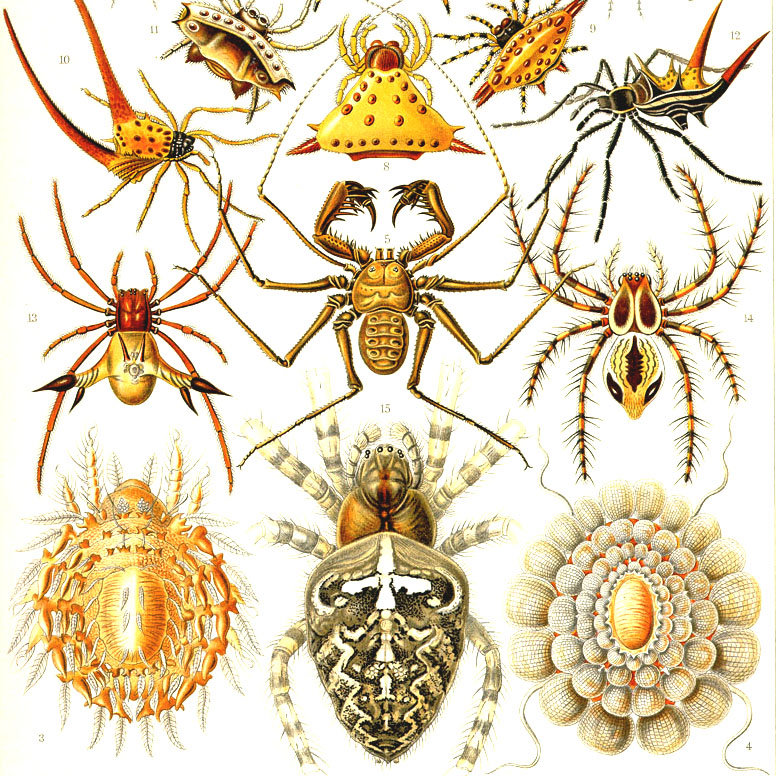Taxonomy
Taxonomy is the science of describing new species and of the revision (redescription, addition, correcting and classification according to relatedness). Specialists in taxonomy and other systematicists often work at natural history museums, which traditionally harbor and curate voucher collections. A number of universities are places of taxonomic-systematic research as well. I is a pity that there are less and less specialists for many plant, fungus and animal groups.
Text: S. Bayer & H. Höfer, Translation: S. Otto
The process of describing a new species is time consuming and accurateness demanding activity. It encompasses recording and describing a large number of characters. Often, the voucher specimen is being measured, its appearance described (color, shape) and pictured in detail in photographs or drawings. The most important part and most demanding task is the analysis and evaluation of the characters in comparison with other individuals (specimen) of the same species and also with closely related but still different species (phenological character analysis). During this process, the researcher (taxonom) recognizes and names so called diagnostic characters, which distinctly separate the species in questions from the other species.
Apart from that, a thorough and precise description of the specimens origin (locality, habitat), circumstances of the finds (methods, collector, date) and other obervations (natural history) are important. Nowadays it is also common to analyse molecular genetic characters (sequences), assisting the comparison of species and their determination. Considering the huge amounts of data in digital databases connected to voucher specimens, a far-reaching standardisation and the inclusion of so called meta data (data about data) is especially valuable for follow-up analyses.
Since 1748 and following a proposal by the botanist Carl von Linné, species are named using two words: the first starting with a capital letter is the genus name, with a genus including several closely related species. The second word starts with a small letter and is called ‘epithet‘. Both words are italicized and their combination (at best with the addition of the describer and year of description) makes the description of a species unmistakable.
At the beginning, the describing taxonom clearifies the affiliation with a certain genus. In cases, where a new species cannot be attributed to an existing genus, one has to describe a new genus first, providing the first part/word of the species name. The second part, the epithet, can be chosen freely by the describer. In earlier days, it was preferred to express one of the distinct characters by an appropriate Latin or latinized Old Greek expression. Due to the large number of species and characters it has become more difficult in recent years to find characteristic species names. Often the appropriate Latin expression for a certain diagnostic character has already been used for another species in this genus. Therefore, nowadays other references are used to come up with a name, e.g. the name of the collector or the name of the locality, where the specimens have been found.
Examples of species names:
Abies alba Mill. – The silver fir was described by Philipp Miller in. In botany the names of the authors are often abbreviated.
Loxodonta africana Blumenbach, 1797 – The African Elephant was described by Blumenbach in 1797.
Homo sapiens Linnaeus, 1758 – genus Homo meaning human, the epithet means “wise“. This species is the only still existing species of humans. The famous scientist Carl von Linné its first describer and also its posthumously designated type (voucher specimen). This extraordinary case is rooted in the fact that both of his works Species Plantarum (1753) und Systema Naturæ (10th edition from 1758) have formed the still valid basis for the scientific nomenclature in botany and zoology.
In order to be able to do this, the taxonom has to work very meticulously, consulting literature and voucher specimens from collections. All descriptions of species in the respective genus and also the ones in closely related genera have to be compared with the studied specimens. One especially has to consider differences in diagnostic characters. Unfortunately, historical descriptions usually were not accompanied by drawings (and certainly not by photographs) and since in the 18. and 19. centuries nobody had an overview of the worldwide species diversity and many parts of the world had not been visited in order to collect organisms, diagnostic descriptions were often brief and are not suited for the differentiation of species.
Therefore it is often necessary to consult the holotype or the type material in order to make comparisons. To this end it is possible to loan material from public collections or to take a look at the material in such collections. European collections important for the study of spiders are situated in London, Paris, Berlin, Frankfurt.
Nowadays worldwide catalogs support investigations in many organism groups, e.g. the World Spider Catalog for spiders. There it is possible to search vor certain species or genera, get an overview on the history of descriptions and synonyms and aquire almost all of the relevant literature as pdf.
The description of a new species is in general connected to a specimen (an individual), to which the name is attached – the holotype. In cases with more specimens, these are designated as paratypes. Only comparisons with the characters of the holotype specimen allow for a correct attribution of other specimens to a species. Due to the possible necessity of later observations, both holotypes and paratypes should be deposited in publically accessible collections, e.g. in museums. There are more kinds of types, e.g. lectogype, neotype, syntype, but they are much rarer than holo- and paratypes, but it is not the place to treat them here.



